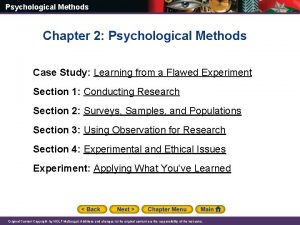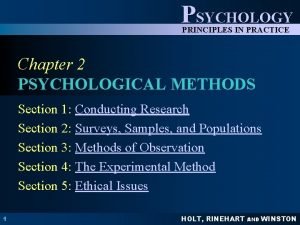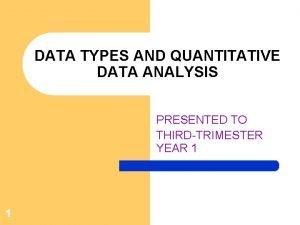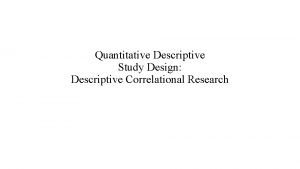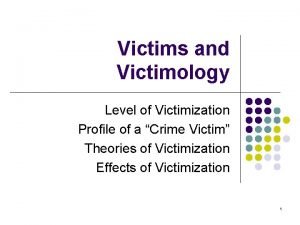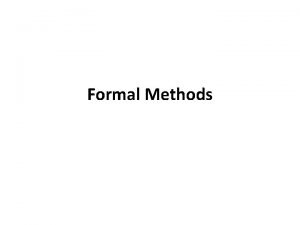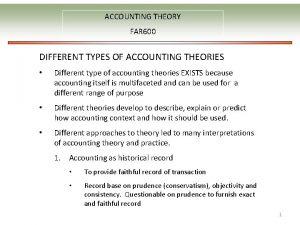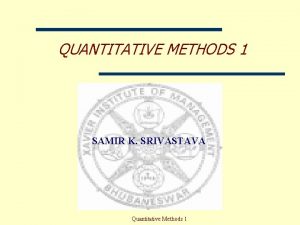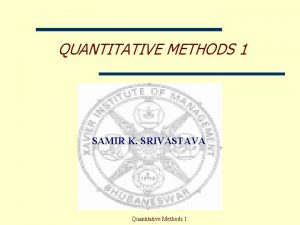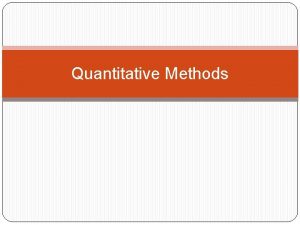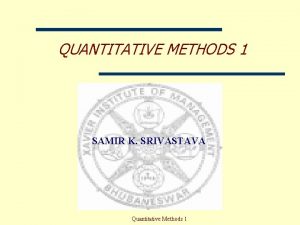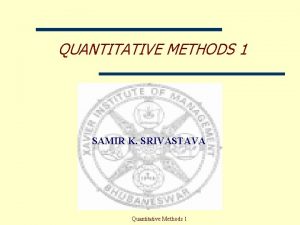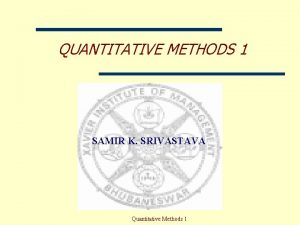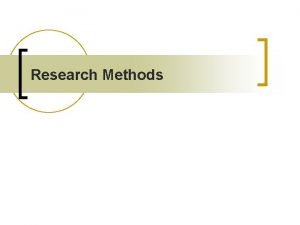Quantitative Research Methods Types of Psychological Research Quantitative

























- Slides: 25

Quantitative Research Methods

Types of Psychological Research Quantitative Research • Analyzes results using numbers • Ignores the context of a person Qualitative Research • Only uses numbers (frequencies, percentages) to generate themes • Focus is on context

Types of Quantitative Research Methods • • • Experiments Correlational Studies Surveys

Characteristics of all Quantitative Research Methods • • • Narrow and focused Objective Meant to be artificial Structured and controlled Not meant to show the context of life Low in reflexivity (researcher does not reflect on how s/he might influence results)

Characteristics of True Experiments (Schumacher & Mc. Millan, 1984) • Compares at least 2 groups or 2 conditions to show causation • Uses at least one independent variable (IV) • Measures at least one dependent variable (DV) • Uses inferential statistics to determine statistical significance

Experimental Variables Independent Variable (IV) is the variable being manipulated and controlled by the experimenter so that the effect can be measured. (Cause) Dependent Variable (DV) is the behavior to be measured that is “dependent” on the independent variable. (Effect) Both variables need to be operationalized

Types of Experimental Design Independent Samples (Between Group Designs) Some subjects are only exposed to part of the independent variable. Utilizes control groups. p Repeated Measures (Within Group Designs) All subjects are exposed to all parts of the independent variable

Independent Samples/Between Groups Recruit a group of participants Divide them into two random groups Group 1 Group 2 This group does the experimental task with the IV set for condition 1 This group does the experimental task with the IV set for condition 2 Measure the DV for each group Compare the results for the two groups

Repeated Measures/Within Groups Recruit a group of participants Condition 1 Condition 2 (Memorize words without music) with music) The group does the experimental task with the IV set for condition 1 The group repeats the experimental task with the IV set for condition 2 Compare the before/after results for the two conditions

Recruiting Participants (Sampling Techniques) Non-representative Samples Typically Used * Convenience (Opportunity) Samples • Self-selected Samples ($$) Notes • Results only generalizable to the individuals studied • Random allocation (to groups or treatments) essential

Strengths of Experiments • Control is the greatest strength • Only research method to show cause and effect

Weaknesses of Experiments • Poor control (of confounding variables) is greatest weakness • Ethics (potential harm, deception etc) can be a problem • Experimenter bias can occur • Low ecological validity is NOT a weakness if triangulation is used

(Other Than True Experiments) • Quasi-Experiments • Field Experiments • Natural Experiments

Quasi-Experiments • Do not use random assignments to groups or conditions • Groups determined by some pre-existing condition (gender, age, anxiety etc) • The IV can, therefore, not be manipulated (how do you manipulate age or gender? ) • Changes in DV may be due to the pre-existing condition or some other extraneous variable(s)

Field Experiments • Data is gathered in a natural setting rather than a lab • An IV is manipulated but changes in DV may be due to many naturally occurring extraneous variable(s) • High in ecological validity but low in internal validity • Subway Study (Piliavin, Rodin & Piliavin, 1969)

Natural Experiments • IV is not predetermined but is identified in the natural environment • Do adopted orphans develop at a different rate than those who are not adopted? • Does instituting a death penalty for murder actually reduce the number of murders? • Compared data from 1972 when the Supreme Court banned the death penalty (Furman v Georgia) to data from 1976 when the Supreme Court repealed the ban (Gregg v Georgia)

Characteristics of Correlational Studies • They show positive/negative relationships between 2 variables • They can be useful when ethics are a concern (smoking risks) • They typically use questionnaires (as opposed to surveys) • They NEVER show causation

Characteristics of Questionnaires • Questionnaires gather data about human characteristics (Neuman, 2006) • They have a limited focus investigating topics such as: • • • One’s behavior (ie, whether you voted) Attitudes/beliefs/opinions (ie, bullying) Certain characteristics (ie, marital status) Expectations (ie, future of your children) Frequencies (ie, number of stressful events)

Correlation Coefficients (r) Ranges from -1. 0 to 1. 0 No Relationship. 00 to. 09 Weak Relationship. 10 to. 29 (Popov et al, 2017). 10 to. 39 (Jamison, 2017)

Correlation Coefficients (r) Ranges from -1. 0 to 1. 0 Moderate Relationship. 30 to. 49 (Popov et al, 2017). 40 to. 79 (Jamison, 2017) Strong Relationship. 50 to 1. 0 (Popov et al, 2017). 80 to 1. 0 (Jamison, 2017)

Strengths of Correlational Studies • Can be used in place of unethical experiments (ie, does increasing the time spent on social media increase depression? ) • Helps to determine relationships between 2 variables • If correlations are strong, useful predictions can be made

Weaknesses of Correlational Studies • Causation can never be established despite the number of replications • Pathway for the correlation is hard to know (ie, do violent TV shows bring-out violence in people or do violent people watch violent TV shows? )

Characteristics of Surveys • Designed to generalize results to a larger target population • Contain a broad range of goals • Uses representative samples (Simple Random Samples, Stratified Random Samples) • Results reported with percentages or correlations

Strengths of Surveys • Many objectives can be studied at the same time • Results can be generalized to a larger (target) population through random samples

Weaknesses of Surveys • Not always certain if survey was completed by the randomly selected participant • People lie • Questions can be biased or confusing
 Sampling methods in qualitative and quantitative research
Sampling methods in qualitative and quantitative research Types of psychological research
Types of psychological research Single blind study
Single blind study Psychology chapter 2 section 1
Psychology chapter 2 section 1 Consumer research methods
Consumer research methods Types of theological research methods
Types of theological research methods Data types in quantitative research
Data types in quantitative research Types of quantitative research designs
Types of quantitative research designs Research question examples
Research question examples Quasi experiment disadvantages
Quasi experiment disadvantages Descriptive correlational design
Descriptive correlational design Research design meaning
Research design meaning Direct and indirect wax pattern
Direct and indirect wax pattern Integrating qualitative and quantitative methods
Integrating qualitative and quantitative methods Mendelsohn's theory of victimization
Mendelsohn's theory of victimization Psychological types of victims
Psychological types of victims Steps in psychological research
Steps in psychological research Types of procurement methods
Types of procurement methods Paired comparison method of performance appraisal
Paired comparison method of performance appraisal Types of formal methods
Types of formal methods Sxsi volume of correlation
Sxsi volume of correlation Types of accounting theories
Types of accounting theories Types of data collection methods
Types of data collection methods Types of error in numerical methods
Types of error in numerical methods Meaning of electronic payment system
Meaning of electronic payment system Permanent and temporary welding
Permanent and temporary welding


